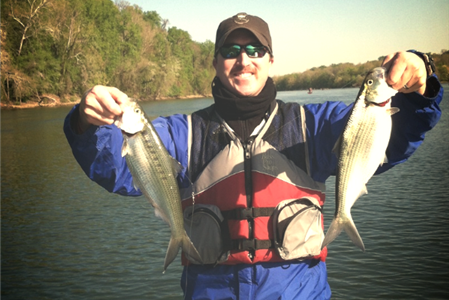
How to catch and cope with, Shad Fever By: Zach Hartman, Owner and Upper Potomac River Guide of Capitol City Fishing
Well, it is late-March, and we know what March is all about right? If you said basketball, then you are probably not a fisherman – not that there’s anything wrong with that – and if you are a fisherman, then you have probably never fished the annual Potomac River shad run. Every year, tidal fishermen delight at the prospect of annual game fish migrations. It starts with the yellow perch, then the white perch, followed by the Hickory and American shad.
Whether you are an avid fisherman or someone looking to connect with the sport of fishing, the annual Potomac River shad run has something to offer you. It is not uncommon for beginner fisherman to catch fish consistently on almost every single cast on a good day of shad fishing; and year in and year out the good days outnumber the bad 10-1. Unlike other types of fishing that can require more skill, research, equipment, and experience to enjoy consistent success, shad fishing offers a unique opportunity to fishermen of all ages and skill levels to experience the thrill of “dialing-in” their quarry and having a successful day of fishing.
However, you cannot just walk to the edge of the Potomac and plop a line in the water and expect to catch fish all day. Below is information and advice that has been compiled over the years from my own experiences. I am not a scientist, nor am I the foremost authority on shad. I am just a guy that loves to fish, and share fishing experiences with others and I believe that the information contained in this article will help others have great time shad fishing as well. With this information, any fisherman capable of casting a line should be able to have a fun, productive, and exciting outing of shad fishing right here in our nation’s capital. This information should cover all you need to know about spin fishing for shad on the Potomac River. For comprehensive information on fly fishing for shad on the Potomac, see this article written my Washington, DC’s, preeminent Fly Fishing Consultant, Rob Snowhite.
Why do the shad run? Shad run up tidal rivers and estuaries to spawn.
When do the shad run?
The shad run typically begins between mid-March and early April. While humans operate based on a clock, calendar, or whatever their wife is telling them to do, fish operate more based off of environmental variables. The strongest contributing variable to fish behavior is water temperature. The second strongest variable (applicable to the shad run) is tide. Fish also respond to water clarity, air temperature, light, and lunar cycles, but for the purpose of simplicity we will focus on water temperature and tide.
So what is the best water temperature to catch shad?
When the water temperature begins to creep up into the 50’s (F) it is time to dust off your fishing gear (if you haven’t already been fishing for perch for a couple weeks) and start thinking about your first shad trip of the year. When the water temperatures hit 55* the shad should be arriving. The more dramatic and consistent the change in the water temperature, the stronger the fish’s instinct to get upriver to spawn and the more contracted the run can become.
How long does the shad run last?
Female shad push up river as far as they can until the water temperature reaches the mid to upper 60’s prior to releasing their eggs and heading back out to sea. The males are following the females, so they will be hot on their tails and headed out to sea. The duration, or length, of the shad run is really determined by the water temperature, so the shad run can last from a few weeks to a couple months depending on the weather.
Where should I fish for shad?
If you live in the District of Columbia, the go-to spot for shad fishing is Fletcher’s Boathouse and the bank of the Potomac in the park near Fletcher’s. At Fletcher’s you can rent a row boat for $14/hour or $25/day, or you can walk to one of the many sites from which to fish from shore and north of Fletcher’s at Chain Bridge. A map with access points for both Fletcher’s and Chain Bridge can be viewed here.
Where in the river is the best place to look for shad?
Ahhh, the million-dollar question! Locating shad in the river can be tricky and often frustrating, especially when you aren’t having any luck and the boat less than 50 yards up stream is pulling them in on every cast. I have found shad in a variety of different areas, and haven’t been able to assign any definitive rhyme or reason why they are in one place or another. Conventional wisdom says that shad prefer strong current. I have found this to be true in most cases, but occasionally find shad in eddies, or pools of calm water outside of the main current of the river, particularly in warmer weather. From my experience, the best place to catch a shad, like other river dwelling fishes, is on the seam of a current. This is the area where waters moving at disparate speeds meet. First let me reflect momentarily on the different parts of the river, as defined by flow, around Fletcher’s Cove. While it is a crude description, it is useful in terms of understanding for what you are looking. Imagine that the river is divided into three strips that run parallel to the shore sectioning the river from one bank to the other.
- Primary Current: This is the strongest current in the river. It is the deepest part of the river and represents the largest volume of water that pushes through it. Beginning on the Virginia shoreline across from Fletcher’s Boathouse and working approximately 1/3 of the way across the river.
- Secondary Current: This is a noticeable current that is adjacent to the primary current, but not quite as strong.
- Cove and other calm pools: The last third of the river is the calm areas adjacent to the shoreline (particularly the DC shoreline) and have very little current.
Look for shad along the various seems of these areas, experimenting with retrieves that cover the entire water column. I have found that more often than not, shad will be deeper, which requires letting the lure or fly sink, followed by a slower retrieve. However, occasionally I have found that the shad prefer a quick and erratic retrieve. Start with a slow retrieve and work it up the water column incrementally faster until you find where the fish are located in the water column.
What kind of rod and reel should I use?
For shad fishing I like to use a 7′ medium action rod with a fast tip. The longer rod enables you to cast farther and the fast tip enhances sensitivity to feel the bite…not that you really need it here. The reel should be a spinning reel spooled with 15lb to 20lb test braided line tied to a 10lb monofilament leader rigged with two shad darts or a shad dart and a spoon. The 15lb to 20lb braid may sound like overkill for light tackle fishing, but this is typically 4lb to 6lb mono diameter, and I find this line to be the most versatile for the fishing that is done in the DC Metro area.
Now get out there and catch some shad. When you do, this link will help you identify your catch.
Zach Hartman is owner and guide of Capitol City Fishing. Born and raised in Sarasota, Florida, and the son of a Charter fishing captain, Zach has more than two decades of fresh and saltwater spin and fly fishing experience. Zach is an experienced outdoor leadership training and team building instructor, has guided whitewater trips in western North Carolina, and is an experienced white water canoeist and outdoor enthusiast. Zach is currently licensed to guide river trips by the Maryland state Department of Natural Resources.








Leave a Reply